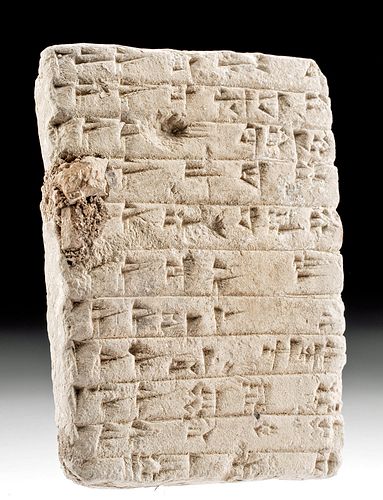Translated Babylonian Clay Cuneiform School Tablet
Lot 67c
About Seller
Artemis Fine Arts
686 S Taylor Ave, Ste 106
Louisville, CO 80027
United States
Selling antiquities, ancient and ethnographic art online since 1993, Artemis Gallery specializes in Classical Antiquities (Egyptian, Greek, Roman, Near Eastern), Asian, Pre-Columbian, African / Tribal / Oceanographic art. Our extensive inventory includes pottery, stone, metal, wood, glass and textil...Read more
Categories
Estimate:
$2,000 - $3,000
Absentee vs Live bid
Two ways to bid:
- Leave a max absentee bid and the platform will bid on your behalf up to your maximum bid during the live auction.
- Bid live during the auction and your bids will be submitted real-time to the auctioneer.
Bid Increments
| Price | Bid Increment |
|---|---|
| $0 | $25 |
| $300 | $50 |
| $1,000 | $100 |
| $2,000 | $250 |
| $5,000 | $500 |
| $10,000 | $1,000 |
| $20,000 | $2,500 |
| $50,000 | $5,000 |
| $100,000 | $10,000 |
| $200,000 | $20,000 |
About Auction
By Artemis Fine Arts
Feb 13, 2020
Set Reminder
2020-02-13 10:00:00
2020-02-13 10:00:00
America/New_York
Bidsquare
Bidsquare : Exceptional Antiquities, Asian, Ethnographic
https://www.bidsquare.com/auctions/artemis-gallery/exceptional-antiquities-asian-ethnographic-4848
An important one-day auction featuring museum-worthy examples of Egyptian, Greek, Roman, Etruscan, Near Eastern, Far East / Asian, Pre-Columbian, African / Tribal, Oceanic, Native American, Spanish Colonial, Russian, Fossils, Ancient Jewelry, Fine Art, so much more! Artemis Fine Arts info@artemisfinearts.com
An important one-day auction featuring museum-worthy examples of Egyptian, Greek, Roman, Etruscan, Near Eastern, Far East / Asian, Pre-Columbian, African / Tribal, Oceanic, Native American, Spanish Colonial, Russian, Fossils, Ancient Jewelry, Fine Art, so much more! Artemis Fine Arts info@artemisfinearts.com
- Lot Description
Ancient Near East, Babylon, Middle Babylonian Period, ca. mid to late 2nd millennium BCE. A fine example of a rectangular form with one flat face and one convex face, smooth peripheries, and twenty-three inscribed lines for writing. One side of the tablet is filled with several lines of neatly inscribed cuneiform text that appear to have similar characters at the beginnings, though the subject of this text is still a mystery. The reverse side features four partially written lines that appear to contain a list of names starting with "Ili-" and then "Apil-Sin," then six blank lines, and then the last line with illegible cuneiform characters. Lucite display stand for photography purposes only. Size: 3" W x 4.125" H (7.6 cm x 10.5 cm)
Cuneiform script is one of the oldest known writing systems in the world, made using a reed as a stylus and scratching wedge-shaped marks onto clay tablets. Early cuneiform was pictographic, but in the 3rd millennium BCE it shifted to the more abstract form you see here. These cuneiform tablets are some of the roughly 2 million known from this culture; of these, between 30,000 and 100,000 have been translated. The earliest translations came in 1836 from the work of French scholar Eugene Burnouf and by the 1850s multiple scholars were able to produce similar translations, meaning the language had been deciphered.
Provenance: private New York, New York, USA collection; ex-private prominent D.K. collection, New York, USA, acquired in the 2000s
All items legal to buy/sell under U.S. Statute covering cultural patrimony Code 2600, CHAPTER 14, and are guaranteed to be as described or your money back.
A Certificate of Authenticity will accompany all winning bids.
We ship worldwide and handle all shipping in-house for your convenience.
#153095Repairs to areas of periphery and one corner, with small chips and light adhesive residue along break lines. Minor nicks to both faces and peripheries, with light encrustations, and softening to some inscribed cuneiform characters. Nice earthen deposits throughout. Some cuneiform characters are still legible.Condition
- Shipping Info
-
All shipping is handled in-house for your convenience. Your invoice from Artemis Gallery will include shipping calculation instructions. If in doubt, please inquire BEFORE bidding for estimated shipping costs for individual items.
-
- Buyer's Premium



 EUR
EUR CAD
CAD AUD
AUD GBP
GBP MXN
MXN HKD
HKD CNY
CNY MYR
MYR SEK
SEK SGD
SGD CHF
CHF THB
THB













